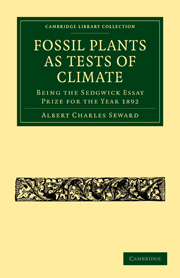Book contents
- Frontmatter
- PREFACE
- Contents
- Introduction
- Chapter I HISTORICAL SKETCH
- Chapter II PLANT DISTRIBUTION
- Chapter III PLANTS AND LOW TEMPERATURES: ARCTIC VEGETATION
- Chapter IV THE INFLUENCE OF EXTERNAL CONDITIONS UPON THE MACROSCOPIC AND MICROSCOPIC STRUCTURES OF PLANTS
- Chapter V ANNUAL RINGS IN RECENT AND FOSSIL PLANTS
- Chapter VI ARCTIC FOSSIL PLANTS
- Chapter VII CARBONIFEROUS PERIOD
- Chapter VIII PLEISTOCENE PLANTS AND CONCLUSION
- List of Works referred to in the Text
- Index
Chapter IV - THE INFLUENCE OF EXTERNAL CONDITIONS UPON THE MACROSCOPIC AND MICROSCOPIC STRUCTURES OF PLANTS
Published online by Cambridge University Press: 07 September 2010
- Frontmatter
- PREFACE
- Contents
- Introduction
- Chapter I HISTORICAL SKETCH
- Chapter II PLANT DISTRIBUTION
- Chapter III PLANTS AND LOW TEMPERATURES: ARCTIC VEGETATION
- Chapter IV THE INFLUENCE OF EXTERNAL CONDITIONS UPON THE MACROSCOPIC AND MICROSCOPIC STRUCTURES OF PLANTS
- Chapter V ANNUAL RINGS IN RECENT AND FOSSIL PLANTS
- Chapter VI ARCTIC FOSSIL PLANTS
- Chapter VII CARBONIFEROUS PERIOD
- Chapter VIII PLEISTOCENE PLANTS AND CONCLUSION
- List of Works referred to in the Text
- Index
Summary
Habit and Size of Plants in relation to Climate.
The inference has often been drawn, in the case of Coalmeasure plants particularly, that the woody structure and treelike form of plants, whose descendants we are familiar with as genera without woody stems, point to tropical conditions of climate.
Size has been considered by many an argument in favour of tropical climates.
To refer briefly to a few points bearing on this question.
Plants with woody stems are able to live through the winter of the cold temperate zones, because the lignification of part of the plant tissues is followed by a development of cork, a screen against cold.
In some cases a protection is also afforded against cold by the collenchymatous nature of the subepidermal tissues; these cells with their thickened angles, characteristic of collenchyma, affording a shield against cold to the more delicate tissue of the phloem and cambium. Areschoug1 has illustrated this in the case of Leycesteria formosa.
In the warm temperate zone woody plants increase in number, and often substitute an evergreen for a deciduous habit. In the tropics, too, woody plants are abundant. There the wood is not a safeguard against the influence of cold, but serves to give the plants that firmness which they require to enable them to support their branches. In a tropical climate, cork must be looked upon, not as a screen from cold, but as a regulator of transpiration of which it prevents excess.
- Type
- Chapter
- Information
- Fossil Plants as Tests of ClimateBeing the Sedgwick Essay Prize for the Year 1892, pp. 55 - 76Publisher: Cambridge University PressPrint publication year: 2009First published in: 1892



